Switzerland is a stunning nation! It’s famous for its Swiss Alps and numerous lakes, but visitors frequently overlook the nation’s rivers.
Magnificent rivers that connect the countryside are abundant in Switzerland. They are without a doubt among Switzerland’s most beautiful natural features, beginning as tiny streams in the mountains, cutting through the meadows, running into and out of the enchanted lagoons, and into the lowlands.
Let’s take a look at some of the best rivers in this beloved country.
Rhine River
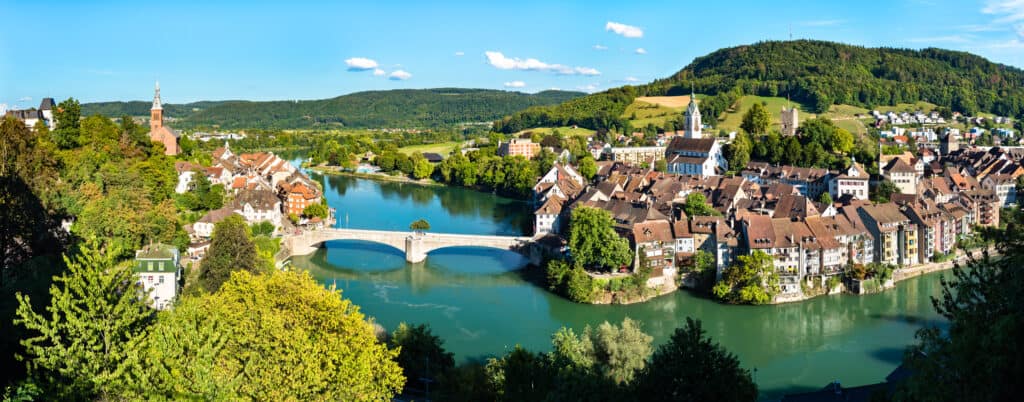
The Rhine is a beautiful river that runs primarily in the north across Germany and the Netherlands.
©Leonid Andronov/Shutterstock.com
One of the most significant rivers in Switzerland, the Rhine, rises in the canton of Grisons (Graubünden) in the southern Swiss Alps. Due to its prominence as a major commercial and transportation corridor in Europe, the Rhine has a significant historical legacy.
In addition, the river is also the second-longest in central Europe, with 233 miles of its length passing via its origin in Switzerland. The Rhine, along with its tributaries, runs primarily in the north across Germany and the Netherlands before draining into the North Sea at a distance of 764 miles.
This well-known river passes through Basel in addition to a few other suburban areas, including Chur, Kreuzlingen, and Schaffhausen. Diving into the Rhine is a favorite summertime activity for Basel residents.
Tourists let the river’s flow carry them on a magical city tour. To make sure visitors are conscious of the safety precautions and swimming circumstances, it’s best to first review the city’s water regulations.
Thur
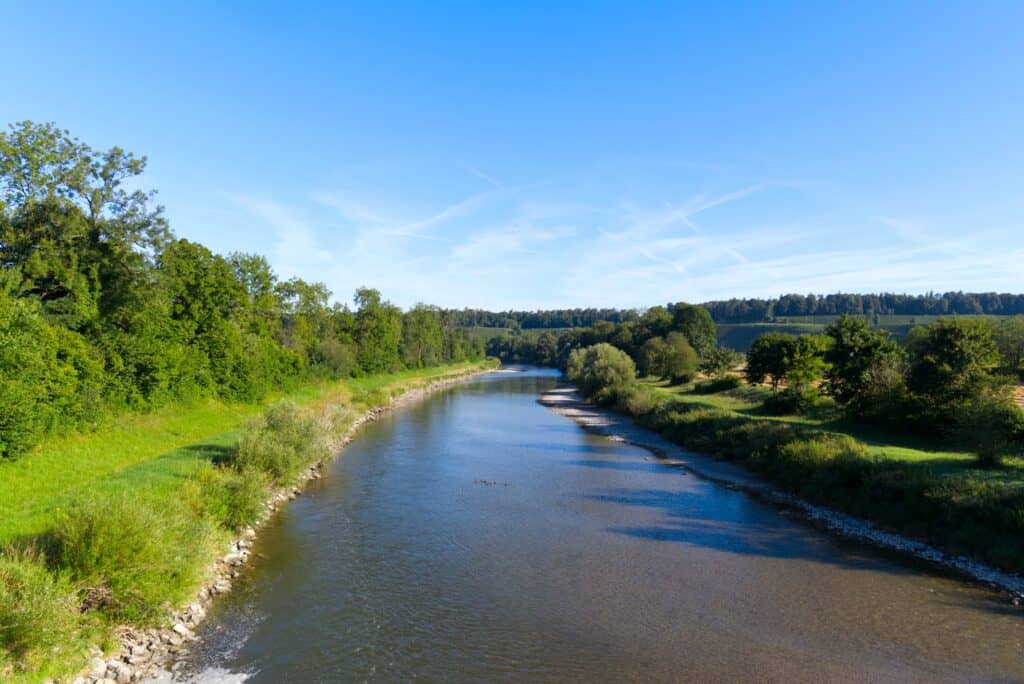
Thur River passes through woodlands, vineyards, and charming, picturesque villages.
©Michael Derrer Fuchs/Shutterstock.com
Eastern Switzerland’s main river, the Thur, is also a tributary of the Rhine. The river’s 78-mile overall length includes elements of the cantons of Zürich, St. Gallen, Thurgau, and its source in the Toggenburg valley.
Thur is the biggest Swiss river without a natural or man-made lake. Because of this, it is notorious for floods. It has been involved in numerous rehabilitation and flood mitigation initiatives.
In light of this, Thur’s flow has created bends and cascades as it passes through woodlands, vineyards, and charming, picturesque villages. This river created the gorgeous Thur Meadows, which is home to numerous unique flora and fauna.
The River Limmat & Linth
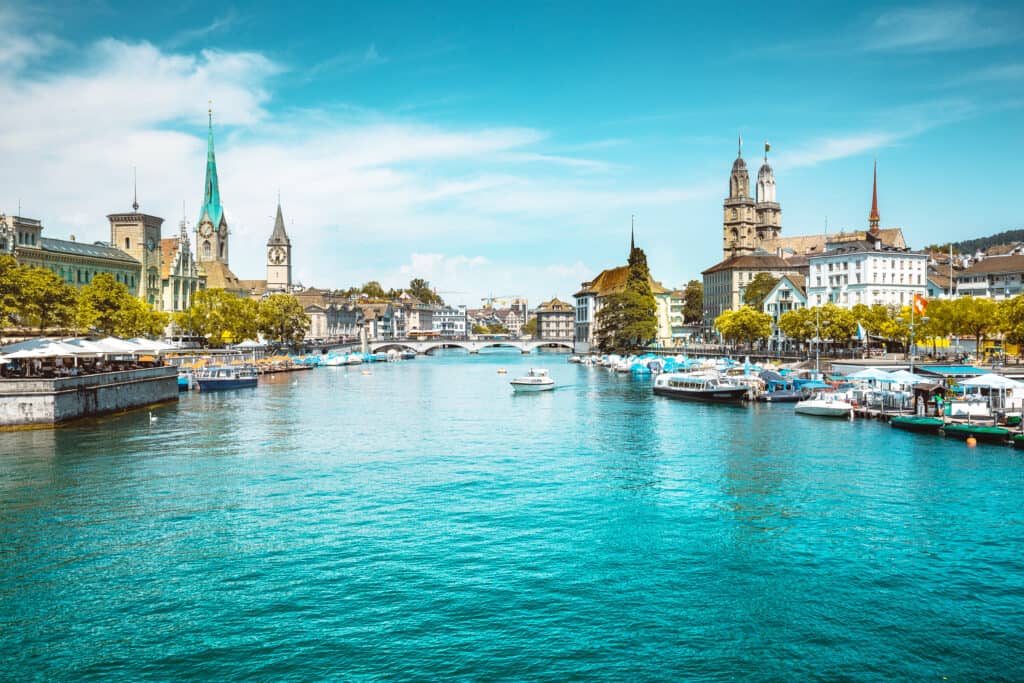
The Limmat River starts when it emerges from Lake Zurich and passes directly through the heart of Zurich’s Old Town.
©canadastock/Shutterstock.com
The Limmat & Linth, another of Switzerland’s longest rivers, are 87 miles long when united by Lake Zurich. The Linth River rises in the highland village of Linthal and empties into Lake Zurich.
This waterway, which nowadays generates power at hydroelectric power plants, traditionally made a significant contribution to the local manufacturing industry. The Limmat River starts when it emerges from Lake Zurich and passes directly through the heart of Zurich’s Old Town.
It hardly flows for 22 miles prior to reaching the Aare River downstream, traveling through the magnificent old village of Baden. Despite this, the river is breathtakingly gorgeous the entire time and is a key draw for the city. If you’re in Zurich, you must take a boat along the water, and if it’s summer, you should experience splashing in the pools next to the river with amazing views of the Old Town.
Ticino

The Ticino River is among the four river systems that originate in the Gotthard region.
©Cristian Visentini/Shutterstock.com
The most significant perennial left-bank tributary is the Ticino River. Its upper section flows through the Swiss canton that bears its name. In addition to the Rhône, Reuss, and Rhine, it is among the four river systems that originate in the Gotthard region.
The Alps glaciers supply the river, and it originates in Switzerland’s Val Bedretto, between the cantons of Valais and Ticino. It then runs around Lake Maggiore and into Italy. The water is chilly, and it is not wise to swim unless you’re a confident, strong swimmer because there are powerful undercurrents.
There are two locations close by where you can rent river boats, canoes, or kayaks. Visitors also have the option of kicking back and having a picnic on the shore.
Aare River
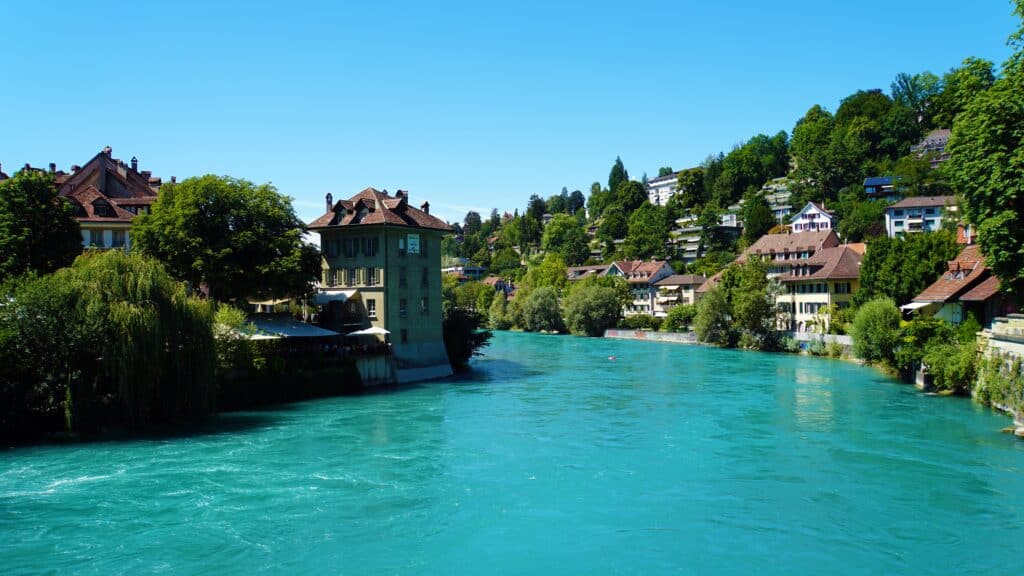
The stunning blue waters of the Aare surround the main areas of Bern, the capital of Switzerland.
©ToYoPhoTo/Shutterstock.com
Aare or Aar is a river that flows into the High Rhine and originates in Bern canton in the Aare Glacier in the Bernese Alps. It is one of the longest rivers in Switzerland, rising and flowing through the nation at 183 miles.
The stunning blue waters of the Aare surround the main areas of Bern, the capital of Switzerland, and a UNESCO World Heritage Site. Locals and tourists gather on the famed banks of the river in the spring and summer to go swimming and tanning by the cool water.
Popular locations in the city where you may unwind while taking in the wonderful scenery of the water and the city are the two public, open-air river bathing pools of Marzili and Lorraine. The Aare permits a variety of different water activities other than swimming, including surfing, kayaking, rowing, and tubing.
The Verzasca River

The deep green Verzasca is the world’s cleanest river.
©Simon Dannhauerr/Shutterstock.com
The Verzasca is a 19-mile-long Swiss Alpine River that flows into Lake Maggiore from Pizzo Barone. It is well-known for its dangerous currents as well as its colorful stones and crystal-clear waters. A few miles upriver from Lake Maggiore is the Verzasca Dam.
The ravine is popular for bungee jumping, and this river is a well-liked spot for scuba diving. Springtime to early fall are often the ideal months for scuba diving. The Verzasca is also the world’s cleanest river.
The crystal-clear water has a temperature range of 45 to 50 degrees. The river isn’t deep; its maximum depth is 33 feet. However, in some areas, strong underwater currents are present, making Verzasca unsafe for swimming.
Reuss River
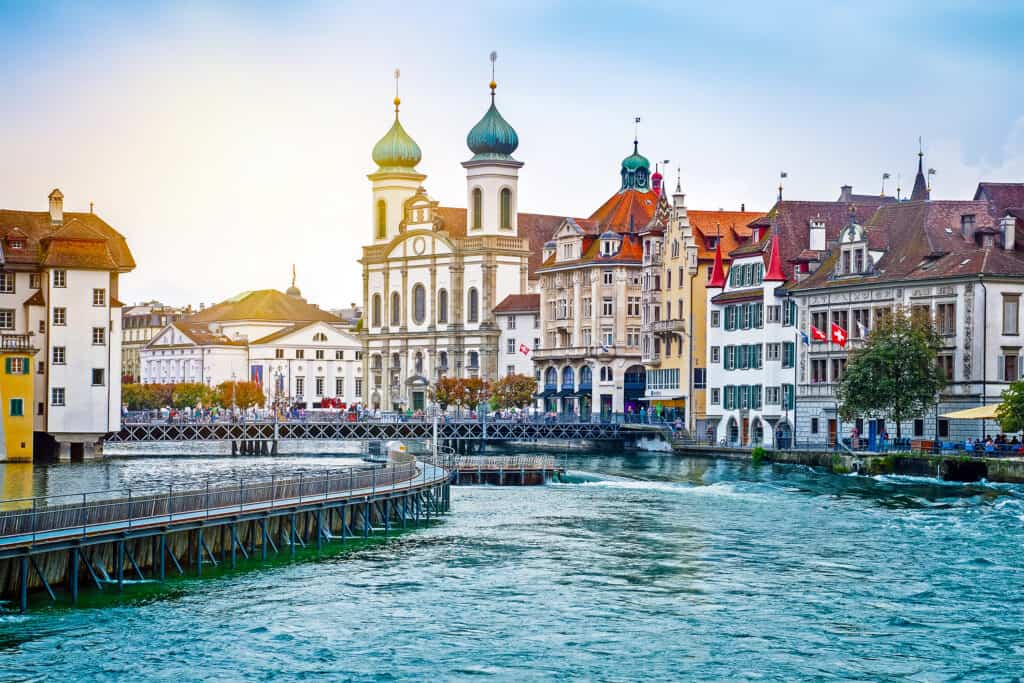
The Reuss is a favorite among canoeists since they can take in the enchanted landscape along the river.
©Pani Garmyder/Shutterstock.com
The Reuss River likewise has its source in the Swiss Alps, in the Gotthard massif, which is also the location of the Rhine and Rhone. This river originates in the Swiss Alps and flows throughout central Switzerland for about 99 miles before entering Lake Lucerne on the southern end, exiting the lake at the city of Lucerne, and finally coming to an end where it meets the Aare River near the town of Gebenstorf.
The Reuss is a favorite among canoeists since they can launch their expedition from the town of Bremgarten and take in the enchanted landscape until the river meets the Aare at Gebenstorf.
It’s simple to rent kayaks and take a paddle tour, and this is a wonderful way to experience the breathtaking Swiss scenery along the way. While exploring the comparatively small nation of Switzerland, one must not overlook the Reuss river because it is so breathtaking.
The Rhone River

The beautiful Rhone River is the second-longest river in Switzerland that isn’t a tributary.
©Proslgn/Shutterstock.com
The Rhone is a well-known Swiss river that rises at the Rhône glacier in the province of Valais, high in the Swiss Alps. It is the second-longest river in Switzerland that isn’t a tributary and one of the country’s longest rivers overall.
Upon crossing the border into France and pouring into the Mediterranean Sea, it travels 164 miles throughout the nation. The Rhone descends from the Alps into Lake Geneva, then travels across Lake Geneva, the metropolis of Geneva, and France, eventually emptying into the Mediterranean Sea.
The Rhone’s exit from Lake Geneva in Geneva is among the best spots to view it. There, the Rhone River merges with the Arve River and undergoes a coloration change from a dark blue to a more vivid peacock blue. A walk along the river’s breathtaking shores is essential.
Up Next
- How Deep is Lake Geneva? Plus, Other Incredible Facts
- 10 Best Mountains in Europe to Climb
- Discover 6 of the Clearest Rivers in the World
- Historic Drought Threatens the Rhine: German, Dutch, and Swiss Economies Shudder
The photo featured at the top of this post is © SCStock/Shutterstock.com
Thank you for reading! Have some feedback for us? Contact the AZ Animals editorial team.






